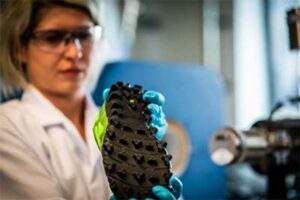
James Baker is the CEO of Graphene@Manchester, the organisation that includes the National Graphene Institute (NGI) and the Graphene Engineering and Innovation Centre (GEIC – pronounced like ‘geek’) both are based at The University of Manchester in the UK.
James and I are meeting at the new GEIC. It is habitable, but not officially opened yet and still being fitted out with world class laboratory and production facilities for making and testing graphene products. There is a sense of excitement and purpose around this development and it feels energising.
I’m here to find out more about the GEIC and how it fits with the world of graphene, so we start talking…
Can you tell us where you see graphene right now?
Much of the basic science has been done, we know a lot about the properties of graphene and what it can do.
Most of the activity over recent years can be seen as graphene as a technology push. You can think of this as graphene solutions looking for a problem. This approach has had some market impact but there is much more to do.
We are starting to see an underlying change where graphene is being embedded in real products solving customer problems and creating saleable benefits. This changes the dynamic to a market pull.
I believe we are in a transition phase moving from the technology push to a market pull and we will look back on the next few years as a tipping point where the promise of graphene started to be realised in improved commercial products.
Can you give me an example of graphene creating marketable benefits?
 A few weeks ago a company called inov-8 launched the world’s first ever graphene sports shoes.
A few weeks ago a company called inov-8 launched the world’s first ever graphene sports shoes.
The high performance shoes have a rubber outsole made from a graphene composite.
This makes them 50% stronger, 50% more elastic and 50% harder wearing than the standard high performance sports shoe.
You would think that making shoes last longer would mean customers would buy less often and the market would shrink. However the reverse is happening as more customers realise the improved performance the market actually increases. This is just one example, there are many more.
How does the GEIC fit in to all this?
 The GEIC is one component of the Graphene City vision from the University of Manchester that aims to create a thriving knowledge economy based around graphene and other 2D materials. It is part of a scientific and technological ecosystem together with the NGI and the new Henry Royce Institute, a national institute for advanced materials also based in Manchester.
The GEIC is one component of the Graphene City vision from the University of Manchester that aims to create a thriving knowledge economy based around graphene and other 2D materials. It is part of a scientific and technological ecosystem together with the NGI and the new Henry Royce Institute, a national institute for advanced materials also based in Manchester.
There is nowhere else in the world with such a concentration of graphene expertise combined with hundreds of millions of pounds of investment.
The GEIC is housed in the Masdar building; a purpose built multi-million pound development that will open in December. It contains the latest state of the art equipment and will be a unique facility to lead the commercialisation of graphene and other 2D materials. The leadership is different too.
Where most facilities are academic-led, the GEIC is industry-led and designed to accelerate bringing graphene technologies to market. The GEIC is industry focussed.
What capabilities do you have at the GEIC?
We have laboratories with five functional capabilities:
The capability of the GEIC, complemented by the NGI and Manchester’s expert knowledge base will allow commercial partners to rapidly prototype and develop products.
So, what can the GEIC do?
Put yourself in the place of an industry partner who is working with us to solve a problem or improve a product. We can assemble world-class experts to help you think through the issues and devise solutions in a morning workshop.
The laboratories can be harnessed to rapidly develop a response so that by the afternoon you could have a prototype in your hands that you can touch, feel and test. There are not many places that will help you go from problem to prototype in a day.
We are not claiming we’ll be able to solve your problems in one go. What we can do is help you innovate through a fail-fast-learn-improve approach. This accelerates the many small improvements that ultimately create the optimised product on which successful businesses are based.
This seems to be just what industry needs, has there been much interest?
Yes, we have a lot of interest in us. The GEIC is not open yet and we have already announced our first three industrial partners. First Graphene Ltd, Haydale Graphene Industries, and Versarien PLC have each agreed to partner with us to develop and commercialise graphene products and applications. There are at least another eight potential partners waiting. In fact I must talk to one of them in a few minutes…
James has to dash to his next meeting and as I’m leaving the building I reflect on the fact that both of us were swept up with the energy and enthusiasm of this place. I depart with a feeling that this will be another success for Manchester


© Copyright 2024 Nixene Publishing Privacy Policy Cookie Policy Website Design by Pivotal Marketing